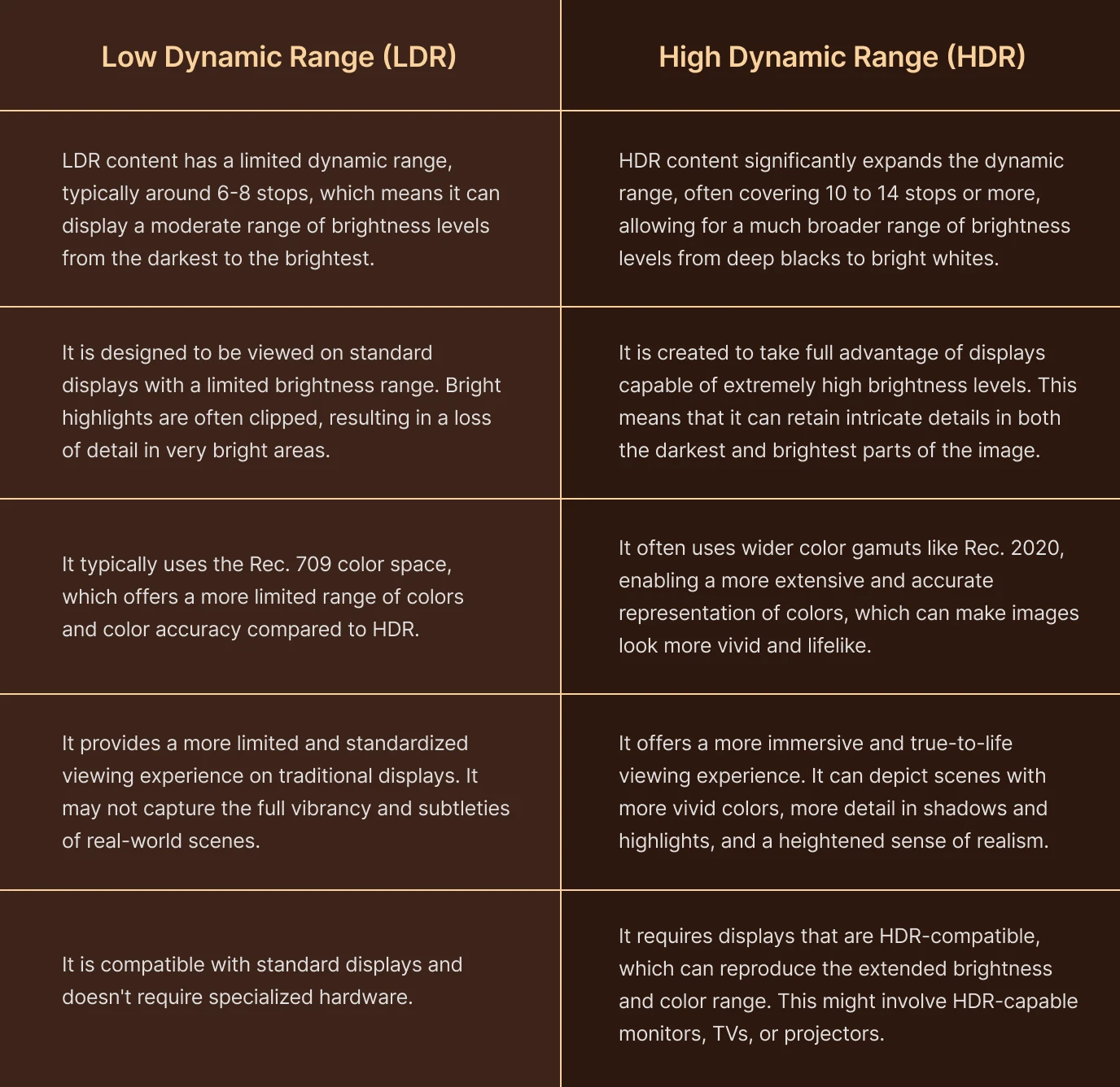High Dynamic Range (HDR) video has emerged as a game-changer in the world of streaming media. It’s the innovation that promises to transform the way viewers experience and consume video content, making our screens come alive with stunning clarity, vibrant colors, and a level of realism that was once thought unattainable.
If you’re wondering what HDR video is and how it impacts your viewing experience, you’ve come to the right place. In this comprehensive guide, we’ll delve deep into the world of HDR video, breaking down the technology, its benefits, and the impact it has on your favorite movies, TV shows, and even the videos you create yourself.

HDR video and its significance in the world of video content
High Dynamic Range (HDR) video is a significant advancement in the world of video content creation and consumption. It enhances the visual experience by expanding the range of contrast and color that a video can display, resulting in more lifelike and vibrant images.
Improved Contrast:
HDR extends the contrast range between the darkest and brightest parts of an image or a video clip. This means that shadows have more detail, and highlights are brighter and more realistic. This heightened contrast leads to a more immersive viewing experience.
Wider Color Gamut:
HDR content can display a wider range of colors compared to standard dynamic range (SDR) video. This wider color gamut means that you see more accurate and vibrant colors, providing a more true-to-life visual experience.
Realistic Lighting:
HDR allows for the presentation of video content that more closely resembles how the human eye perceives light. It can replicate the nuances of natural lighting, such as the way the sun’s rays glint off water, or how car headlights illuminate a dark street.
Better Detail in Shadows and Highlights:
HDR enables viewers to discern more details in both the darkest and brightest areas of the video. This can be particularly important for genres like action movies or documentaries where preserving fine details is crucial.
Enhanced Immersion:
The combination of improved contrast, wider color gamut, and realistic lighting in HDR videos makes for a more immersive experience. It draws viewers deeper into the content and can make them feel like they are part of the scene.
Future-Proofing:
As display technologies continue to advance, HDR content is more future-proof. It can take advantage of new display capabilities and provide a high-quality experience even on the latest screens.
Industry Standardization:
Various HDR formats and standards have been established, such as HDR10, Dolby Vision, and HLG. These standards help ensure consistency and compatibility across different devices and content sources.
Increasing popularity and adoption of HDR video technology
HDR technology significantly improves the quality of video content by expanding the contrast ratio and increasing the range of colors and brightness. This results in more vivid, lifelike, and immersive visuals, making it a compelling choice for content creators and consumers.
The availability of HDR-compatible displays, including TVs, monitors, and projectors, has grown rapidly. Consumers are increasingly seeking out HDR-compatible devices to fully appreciate the enhanced viewing experience. Many filmmakers and content creators are embracing HDR technology to provide viewers with a more immersive and engaging experience. Streaming platforms, such as Netflix and Amazon Prime Video, have made HDR content more accessible, driving the demand for HDR production.
Understanding HDR video technology – What is HDR Video?
HDR is also gaining traction in the gaming industry. Both gaming consoles and gaming monitors are supporting HDR, enhancing the realism and aesthetics of video games.
HDR, or High Dynamic Range, video is a technology that enhances the visual quality of video content by expanding the range between the darkest and brightest areas of an image. This increased dynamic range results in more lifelike and immersive viewing experiences.
Key aspects of HDR video technology
- Dynamic Range: In standard dynamic range (SDR) video, the range between the darkest and brightest parts of the image is limited. This can lead to loss of detail in very bright or very dark areas, making the image look less realistic. HDR expands this range, allowing for more detail in both shadows and highlights.
- Brightness and Contrast: HDR video features significantly higher peak brightness levels compared to SDR, making the bright parts of the image appear much more vivid. This increased contrast enhances the overall visual impact.
- Color Accuracy: HDR also improves color accuracy by displaying a wider gamut of colors. This means that you can see more shades and nuances in colors, which adds to the realism of the image.
- Local Dimming: Some HDR displays utilize local dimming technology to enhance contrast further. This means that different areas of the screen can be independently controlled to adjust brightness, resulting in deeper blacks and brighter highlights in the same frame.
- Content Compatibility: To fully enjoy HDR video, you need both a compatible display (like an HDR-capable TV or monitor) and HDR content. Many streaming platforms, Blu-ray discs, and video games offer HDR versions of their content.
The Basics of Dynamic Range
Dynamic range is a fundamental concept in photography, videography, audio, and various other fields. It refers to the difference between the darkest and the brightest elements in an image, sound, or signal. Here are the basics of dynamic range:
Dynamic Range in Photography/Videography:
- In photography and videography, dynamic range refers to the range of brightness levels that can be captured or displayed in an image or video.
- A camera or sensor’s dynamic range is usually measured in stops, which are logarithmic units. Each stop represents a doubling or halving of the amount of light.
High Dynamic Range (HDR):
- High Dynamic Range (HDR) imaging or video technology expands the dynamic range beyond what can be achieved with standard imaging or video techniques.
- HDR captures or displays a broader range of brightness levels, resulting in more detail in both shadowed and highlighted areas.
Low Dynamic Range (LDR):
- Low Dynamic Range (LDR) represents standard imaging and video that doesn’t employ HDR techniques.
- In LDR, the dynamic range is limited, and some details in highlights or shadows may be lost or appear as pure white or pure black.
In Graphics and Displays:
- In computer graphics and displays, dynamic range is important for rendering realistic images and videos on screens.
- HDR displays can provide a more immersive viewing experience by showing a wider range of colors and brightness levels.
Compression and Expansion:
In some cases, dynamic range compression or expansion is applied to audio and video signals to make them more suitable for specific purposes, like broadcasting or playback.
Difference Between Low Dynamic Range (SDR) And High Dynamic Range (HDR)

How HDR Enhances Video Quality?
High Dynamic Range (HDR) enhances video quality by expanding the range between the darkest and brightest parts of an image, resulting in more lifelike and visually stunning content.
- It displays a wider range of brightness levels, from deep blacks to bright whites, which creates more contrast in the image.
- With a wider dynamic range, HDR preserves fine details in both shadowed and highlighted areas of the video. This ensures that subtle textures and intricate patterns are visible, which can be lost in standard dynamic range (SDR) content.
- HDR allows for a broader color spectrum, which means more colors and shades can be displayed.
- HDR technology effectively captures both the brightest and darkest parts of an image, preventing highlights from washing out and shadows from becoming too dark.
What are the different formats of HDR?
Dolby Vision:
- Dolby Vision is an advanced HDR format developed by Dolby Laboratories. It is known for its superior image quality and dynamic metadata, which allows for scene-by-scene or even frame-by-frame adjustments to optimize the content’s presentation.
- Dolby Vision content can deliver a brightness range of up to 10,000 nits, making it one of the most capable HDR formats in terms of luminance.
- It is compatible with both LCD and OLED displays and is widely supported by many high-end TVs, streaming services, and 4K Ultra HD Blu-ray players.
HDR10:
- HDR10, also known as “open standard HDR,” is one of the most widely adopted HDR formats. It uses static metadata, which means that it applies the same settings for the entire duration of a video or movie.
- It typically supports a maximum peak brightness of 1,000 nits, which is suitable for most HDR content.
- HDR10 is an open standard, so it is widely supported by various displays and content providers.
HDR10+:
- HDR10+ is an extension of the HDR10 format, developed by Samsung in collaboration with other companies. It is designed to address some of the limitations of HDR10, such as its use of static metadata.
- Unlike HDR10, HDR10+ employs dynamic metadata, allowing it to make scene-specific adjustments, like Dolby Vision.
- HDR10+ supports a peak brightness of up to 4,000 nits, providing better support for a wider range of content.
Benefits of HDR
High Dynamic Range (HDR) is a technology used in various forms of media, including photography, television, and gaming, that enhances the quality of visuals by expanding the range between the darkest and lightest areas of an image or video. Here’s an explanation of the benefits you mentioned:
- Enhanced Visual Experience: HDR improves the overall visual quality by providing a wider range of brightness and contrast, resulting in more lifelike and dynamic images.
- Cinematic Excellence: In the world of filmmaking, HDR allows for a more immersive and cinematic experience. It enhances the viewing of movies by preserving details in both bright and dark scenes, resulting in a more realistic and captivating viewing experience.
- Gaming and HDR: HDR in gaming enhance graphics and immersion. It offers brighter highlights, deeper shadows, and more vibrant colors, making in-game worlds and characters look more realistic and engaging.
- Education and Training: In educational and training environments, HDR can be used to present content with exceptional clarity. This is especially useful for medical imaging, scientific visualizations, and any scenario where precise visual representation is crucial.
- Vibrant Colors: HDR enables a wider color gamut, allowing for more accurate and vibrant color reproduction. This is particularly important for content that relies on rich, true-to-life colors, such as nature documentaries and art exhibitions.
- Realism and Depth: HDR enhances the sense of depth and three-dimensionality in images and videos. This can be especially beneficial for architectural visualizations, virtual reality (VR), and simulations.
- Greater Immersion: By providing a more immersive visual experience, HDR content allows viewers to feel more connected to what they are watching, whether it’s a movie, game, or virtual tour.
- Content Creation Flexibility: Content creators benefit from HDR by having greater flexibility in post-production. They can fine-tune the brightness and contrast of their content to achieve the desired artistic effect.
- Accessibility: HDR technology can make content more accessible to a wider audience. For example, it can be used to enhance visual content for people with visual impairments, making it easier for them to perceive details and distinctions.
Conclusion
High Dynamic Range (HDR) video is a revolutionary innovation that has reshaped the landscape of streaming media and content creation. It’s a technology that offers a myriad of benefits, enhancing the visual experience and taking it to new heights. With improved contrast, a wider color gamut, realistic lighting, better detail in shadows and highlights, and an overall enhanced level of immersion, HDR video has captivated the hearts and screens of viewers worldwide.
Muvi supports Dolby vision HDR and will help you create a better viewing experience for your audience. Muvi One stands as the global frontrunner in all-in-one OTT platform solutions, allowing you to launch your own streaming service. Includes websites and apps for mobile & TV. Start a free trial to know more!


















Add your comment